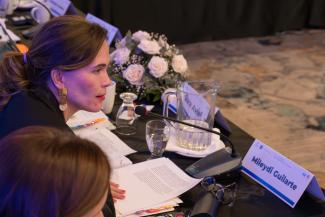Uplifting Women and Girls toward Economic Opportunity
by Mileydi Guilarte, Deputy Assistant Administrator, Bureau for Latin America & the Caribbean
The U.S. Government is reaching a milestone this coming summer—three years since we launched the U.S. Strategy to Address the Root Causes of Migration in Central America (RCS). It may seem daunting to tackle all the underlying reasons why someone might migrate—from lack of economic opportunity, to crime and violence, to increasing levels of corruption and more.
But the good news is, we’re making progress. My recent trip to Guatemala for the U.S.-Guatemala High Level Economic Dialogue (HLED) showed me so many ways we’re making a positive difference through our development work. At the dialogue, the first of its kind with Guatemala, the United States and our Guatemalan counterparts underscored our shared interest in deepening the bilateral partnership in order to stimulate sustainable, inclusive and equitable economic development that would benefit all Guatemalans and the region. For example, we touched on the need to bring in additional investment, build new productive infrastructure, and take full advantage of the more than 20 billion dollars in remittances coming into Guatemala every year–primarily from the United States–to help Guatemalans enjoy better lives at home.
In particular, as I reflect on the discussions at the HLED, I come away even more convinced how important inclusive, equitable growth—that includes decent work for women in all of their diversity and marginalized populations, including in the context of indigenous peoples—will be to creating hope among citizens in the region. Inequality and poverty in Guatemala are concentrated among indigenous communities, which represent half of the population. Only 1 in 10 indigenous women do paid work– and even when they do, they earn 19 per cent less than non-indigenous women.


We know that gender-specific job gaps remain persistent and high in northern Central America. In Guatemala, only half as many women as men in the working-age population are either employed or seeking employment in the formal sector; this rate is also the lowest in the region. And even though the female youth unemployment rates across all three countries have slowly declined since 2020, in this region they continue to be almost double the rates of male youth unemployment.
So as we mark International Women’s Day and Women’s History Month, here are three ways we’re ensuring women and girls have economic opportunities in Guatemala, Honduras, and El Salvador.
Building Vocational Skills
Since 2021, about 30,000 youth, nearly two-thirds of whom were women, from high out-migration municipalities have completed USAID-supported vocational training programs tailored to local labor market needs of northern Central America, ensuring access to decent work post-graduation. Over the same period, more than 12,000 young people were employed in new jobs after completing their vocational training. Emelia, a Guatemalan mother of two, is one of those young people USAID supported. She had graduated from high school with a specialization in digital electronics, but she hadn’t had any success in finding a financially stable job. She realized that she needed to further her education if she was to secure a better financial future for her children. Through training in healthcare and completing entrepreneurship and health technical courses, Emelia is taking control of her life. With the skills she now has, Emelia plans to open a local pharmacy so her family can thrive.
Lifting Up Women Entrepreneurs
In collaboration with Banco de America Central (BAC) Credomatic El Salvador, USAID co-designed a financial credit lending product to address the barriers that women-owned small and medium sized businesses face in accessing conventional loans from banks. Those challenges include lengthy processes of accessing loans, excessive business information requirements, and a lack of collateral. When BAC launched their new lending product in July 2022, they aimed to disburse at least $3.0 million in financing to at least 125 women business owners by September 30, 2024. As of August 2023, BAC had far surpassed its financing goal, mobilizing more than $8.6 million in financing for 235 women-owned small and medium-sized enterprises in 10 different departments of El Salvador, in just 11 months of implementation. That means that many more women-owned businesses can access capital more quickly, allowing them to take advantage of new business opportunities and enjoy higher levels of income and overall well being.
Last year, USAID supported more than 12,000 firms—including women-owned firms—across El Salvador and Guatemala through programs such as this one, to expand investment and increase employment.

Educating the Next Generation
In Honduras, nearly four out of 10 children in third grade do not read at expected levels. But as UNESCO has found, if all the world’s students completed their secondary education, poverty could fall by half. Through a literacy program supported by USAID, Deysi Rápalo, a primary school teacher in Zambrano, Honduras, has created a space for children whose reading and writing skills have lagged, using play time as well as books and letter stencils to help children connect the language they hear and speak to the words they read and write. She is now paying it forward and has held in-person training for fellow teachers to use the instructional toolkit with their students. USAID reached more than 220,000 primary and secondary students in 2023, including more than 99,000 girls, in high out-migration municipalities in El Salvador, Guatemala, and Honduras with programs aiming to improve math and reading skills, keep youth in school, and boost completion rates.
Through these efforts and more USAID is ensuring women and girls across these three countries have the knowledge and skills they need to prosper in their communities. So the time to act is now, to ensure that next year’s Women’s History Month is one where the statistics are no longer in the lead, but our progress is.


